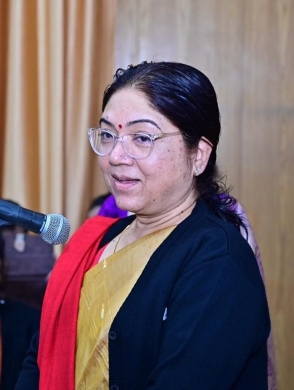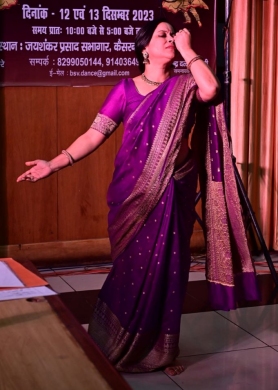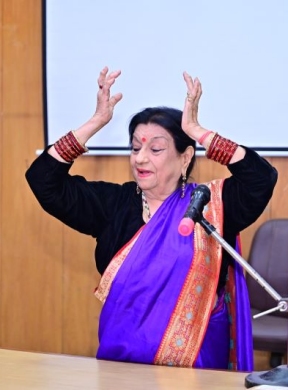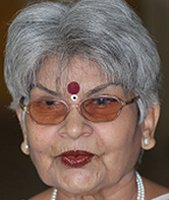
|   |

|   |
A meaningful Kathak seminar - Manjari Sinha e-mail: manjari@sinha.com January 4, 2024 Primarily originating with storytelling "Katha kahe so Kathik kahave", Kathak has gone through significant changes. The original temple tradition of mythological stories gradually adopted the trend of romanticism and technical virtuosity for the Mughal courts and then evolved to reach the proscenium theatre as one of the popular Indian classical dance forms of India. The rich tradition of 'Bhava Pradarshan,' the presentation of moods and emotions (Rasa Bhava), pervades the entire repertoire of Kathak from its nritta aspect in intra forms like Thaat, Aamad, Paran, Kavitta, Gat Nikas, Gat Bhava, etc to the abhinaya aspect emoting the Thumri, Dadra, Ghazal or Bhajan et al. The Dance Department of Bhatkhande Sanskriti Vishvavidyalaya (BSV), Lucknow, organized a Kathak seminar on this very aspect of Kathak dance titled 'Kathak Nritya Ka Bhava Pradarshan' on the 12th & 13th of December 2023 at the Jaishankar Prasad auditorium, BSV, Lucknow. Keeping in mind that an open discussion on the positive influence and scope of the bhava presentation in Kathak will be beneficial for scholars and students of Kathak alike, the organizers invited experts/scholars to share their perspectives and practical experiences on the topic.  Dr. Mandavi Singh Inaugurating the two-day seminar, Dr. Mandavi Singh, the Vice Chancellor (VC) of BSV, who is also a disciple of Guru Lachchu Maharaj, stated, "More than in my official capacity, I welcome you all as a member of the Kathak family. I hope that this seminar, which is my first initiative as the VC, BSV, will benefit from your lifelong experiences and scholarship in the field of Kathak dance and its rich tradition". She further added, "This is a historical place, very close to the Parikhana of Nawab Wajid Ali Shah, a place of sadhana/practice. We have gathered here to think about the Bhava Paksha (emotional/expressional aspect) of Kathak, its aesthetics, and its future possibilities." Uma Dogra from Mumbai, Chairperson, Kathak Kendra, compared the seminar to a Mahayajna where all the scholars were participating as the gods and goddesses. Shama Bhate chairing the first session on the inaugural day, invited the panelists of this session namely Prof. Purnima Pande, Prerana Shrimali, Prof. Kumkum Dhar, and Dr. Vidhi Nagar for their presentations.  Prof. Purnima Pande Prof Purnima Pande opened her presentation on the Katha Vaachan Parampara (the tradition of story-telling in Kathak) by screening a short video of the traditional Kathikas or story-tellers from temples of Ayodhya performing during the Jhula Mahotsava. The performance, she explained, would start with Mangalacharan and then would narrate the mythological stories interspersed with small passages of footwork and a Tihai to break the monotony. A single Katha Vachak would enact different characters with the help of dupatta. Purnima requested Rajashree Shirke to demonstrate it through her 'Mandodari Samvaad' where the use of dupatta differentiated characters like the Sutradhar, Mandodari and Ravan et al. Purnima Pande also stated the fact that the old practitioners of Lucknow Gharana like Thakur Prasad and Kalka-Bindadin Maharaj came from this very tradition of Katha Vachan, that evolved into the classical dance form Kathak prevalent today. Here I want to record my observation about the background music of the video clip which was so important to enhance the Bhava Pradarshan. The video clip of the Jhula Festival started with the Mangal Dhwani, the auspicious 'Roshan Chauki' or shehnai, playing the timely raga Multani. Even the following Arati was accompanied by the temple bells (ghanta ghadiyal) in tune with the main swaras of the raga, Komal Gandhar, Teevra Madhyam, and Pancham. This was followed by the dance where the same tune of the Multani's Teentala bandish worked as the lehera or naghma, the musical refrain, for the dancer's intermittent Tode-Tukde and Tihai to entertain the audience in between the emotive narration of the mythological story. The dancer did use the uttariya (dupatta) to enact different characters, but what created the appropriate ambience, was their inherent knowledge of classical music which went hand-in-hand with the dance!  Rajashree Shirke demo This was also mirrored in Rajashree Shirke's brief presentation inspired by the 'Katha Vachan Parampara'. She used live music for her dramatized 'Ravan-Mandodari Samvad' provided by her versatile son Aniruddha, who sang the contextual chaupais from Ramcharit Manas of Tulasidasa, played the pakhawaj and tabla and provided even the sound effects augmenting varied rasa bhavas. Purnima Pande concluded with a word of caution to the young students present there, stating, "Abhinaya is the art of becoming. The dancer has to mentally become the character he or she is enacting. You can't always show Shiva in his tandava pose. Shiva is not always aggressive. He is also worshipped as Bhole Baba, who is innocent and benevolent too."  Prerana Shrimali Prerana Shrimali, the renowned exponent of Jaipur Gharana, was the next speaker. She underlined the fact and remarked that even the nritta aspect of Kathak is capable of abhinaya. The technical aspect, nritta can also become nritya, full of bhava and abhinaya like Kavitta, Gat Nikas, and Gat Bhava, and even Tatkar, the footwork. The dancer can pour bhavas even into the bols, the mnemonics of nritta, to convey any emotion. Kathak's abhinaya is done not only on sahitya (poetry) but even without sahitya, with great subtlety. There is a rich vocabulary of bols in Kathak, which are created also through impromptu Upaj, the instant improvisations on the spot. This is the reason why the same Thumri or poetry gets a different flavour of expression in the abhinaya of each dancer. Prerana also talked about the sahitya and sangeet of Kathak which needs to be taken with great sensitivity. The loud light and sound effects, the faster pace of dance, and the lack of sensitivity have all affected the abhinaya aspect of Kathak. Shama Bhate suggested that the present day technological changes should be used in our favour rather than being intimidated by the challenges.  Kumkum Dhar & Uma Dogra Kumkum Dhar, groomed under Guru Lachchu Maharaj, emphasized 'Bhava Saundarya', the beauty of bhava, by stating the fact that, "Nothing happens without bhava in the tradition I come from. Every glance would say something!" Mukh Vilas or facial expression went along with every bol, every hand gesture. Since the dance form came from Vaishnava Parampara, shringar bhakti also came alongside. She also mentioned the particular terminology of 'Bhaav Batana', especially prevalent in Kathak, where a variety of symbols are used to express various bhavas. Kumkum has been also a successful Nautanki artiste. When asked what the difference in abhinaya of both genres is, she explained that, "Abhinaya in Nautanki is lokadharmi hence it goes to the extent of melodrama, whereas Kathak abhinaya has to maintain the maryada (discipline) of a classical dance form. My Guru often used the word itmeenan (composure), imperative for effective Kathak abhinaya which is getting lost these days in 'Tezi and Tayyari', fast speed and unnecessary virtuosity. The artistic visuals also augment the Rasa Bhava in dance, like the tuneful swaras do in music. Dhatak Thunga, for instance, can depict an innocent Mugdha, a Madhya, or a Pragalbha Nayika, just by its meaningful visuals." Kumkum suggested that the students should study good literature, listen to good music, etc so that even one line of poetry could be elaborated by adding some Doha, Kavitta, or Urdu couplets to enhance their Bhava Pradarshan. Dr. Vidhi Nagar from BHU, Varanasi, discussed the psychology behind abhinaya. Through a Power Point presentation, she pointed out that, "Two things are important in our upaj or improvisation - creativity and cognition. Our evaluation plays an important part after structuring, rehearsing, and performing abhinaya, therefore psychology has a big role in abhinaya, which is first learned and then delivered." She also screened her video on Jayadeva's ashtapadi "Priye charushile" composed in raga Jhinjhoti.  Shama Bhate  Ameera Patankar demo The second session was chaired by Prerana Shrimali with speakers Shama Bhate, Uma Dogra, Rajashree Shirke and Anuj Mishra. Talking about the changes in the past 75 years, Shama Bhate found that Kathak has become more structured. She talked about Gat Nikas and Gat Bhava which has neither words nor poetry but can depict a whole mythological story like Draupadi Cheerharan or Bhasmasura. 'Kavitta' is such a form in Kathak which has both poetry and chhand. It is a small poem that can describe a big story like Daksha Yajna, which may also be elaborated through intermittent music. To prove her point, she made her student Ameera Patankar present the Kavitta "Praat chali dadhi bechan ko..." interspersed with music. Since the time was morning (praat), it was composed in the morning raga Ahir Bhairav. Second was a long Gat Bhava depicting the whole story of Bhasmasura. Uma Dogra remarked that a bhava or emotion cannot be expressed effectively just through the angika, vachika, and aharya abhinaya unless it is truly felt in your own heart. It is communicated to the rasikas only by creating the exact rasa bhava, through satvika abhinaya. Uma remembered attending workshops of Gurus Kalanidhi Narayanan and Kelucharan Mohapatra, who would stress this and say, "If you are going to perform the fifth ashtapadi, you should also understand the earlier four thoroughly."  Anuj Mishra Speaking from the perspective of 'Bhava Pradarshan in Kathak', Rajashree Shirke shared her own experience of working in the 'Katha Vachan shaili,' the story-telling style. She explained how her technical knowledge of Kathak came in handy while working on this aspect. Demonstrating through the example of the Bindadin Thumri "Shesh phan dagamagaye" composed in Jhaptala, she showed how before enacting the line "kahat Mandodari sunahu Lankapati" she used nritta in Khand Jati, matching the ten beats cycle of Jhaptala to create the aggressive impact of Ravan effectively. She reiterated the fact that once you understand the rasa and feel the bhava, you may easily use the rich technique of Kathak to your advantage. The dance technique is like the ingredients available in the kitchen but how you use them in the recipe of Bhava Pradarshan, is up to you! Anuj Mishra performed "Karpur Gauram Karunavataram" for Bhava Pradarshan. Prof Purnima Pande chaired the first session the next day, with speakers Dr. Veena Singh, Pt. Ram Mohan Maharaj and Dr. Ruchi Khare. Dr. Veena Singh stated, "For me, Kathak is a devotional art or Bhakti Nartan. When the laya or rhythm is internalized, it becomes Bhava Abhinaya. Kathak is connected with spirituality from its very first stance, with the dhyan mudra placed on the heart. This is why Kathak has bhava in both nritta and nritya." To prove her point, she demonstrated "Dhatak Thunga" like a tete-a-tete between two friends.  Pt. Ram Mohan Maharaj Pt. Ram Mohan Maharaj asked a pertinent question. "Why are 25 pirouettes needed for abhinaya? I never saw my father Shambhu Maharaj or my uncles Achchhan Maharaj and Lachchu Maharaj taking chakkars in Bhava Pradarshan. Abhinaya is associated with Nava Rasa. In Bhava Pradarshan, one has to create a particular mood with bhava, not by acrobatics." He demonstrated Thaat, the 'Khade hone ka andaaz', which could convey shringar bhava with just a glance of the Nayika.  Dr. Ruchi Khare Dr. Ruchi Khare talked about the tools of abhinaya (angik, vachik, satvik), and the requisite knowledge or study of sahitya/literature, and music to enhance it. For a demonstration of Sangeet ka Tukda and the Nava Rasas (shringar, veer, hasya, karuna, etc) through Gat Nikas, she asked one of her students who presented all this and the Gat Bhava on Govardhan Leela. The last session chaired by Dr. Ruchi Khare had Urmila Sharma from Prayagraj, Renu Sharma from Lucknow, and Vaswati Mishra from Delhi as speakers. Urmila Sharma expressed her concern about the trivialization of Kathak in general and its Bhava Pradarshan in particular by the populist approach of some so-called Kathak dancers. Renu Sharma read out passages from Sangeet Darpan regarding abhinaya, after talking about the abhinaya and the aesthetics of her Guru Pt. Birju Maharaj. Vaswati Mishra said these days Kathak practitioners are focused more on technique as compared to bhava. Bhava depends on your inclination and conviction. If you are showing a flower, the expression on your face should also convey its sweet smell. The joy of its fragrance should also be communicated. When we are talking of Vipralabdha and Proshitpatika Nayikas it should be remembered that both are parted from their beloved but one has no hopes of his return and the other is sure that he is going to come back. This awareness brings a vast difference in the Bhava Pradarshan of both. Students should be encouraged to reading literature and listening to music,  Padma Sharma Padma Sharma from Mumbai, a senior disciple of Guru Lachchu Maharaj, shared her nostalgic memories of Bhatkhande and demonstrated Bhava Abhinaya on the Dadra "Kaun albele ki naar, jhamajham paani bhare ri" and "Baji ghar aain / Baaji dekhne ko dhain...," the famous composition of Guru Lachchu Maharaj. There was also an interesting question and answer session where students could interact with the scholars and ask their queries. Prof. Mandavi Singh's concluding remarks added important contributions of Raja Chakradhar Singh also, like the inclusion of Prem (love), Sheel (modesty), Smit (smile), and Gati (delicate/graceful walk) in the sixteen adornments, the Solah Shringaar of a Nayika. Talking about the 'Bhava Pradarshan in Kathak', the topic of the two-day seminar, she also cautioned the students. "When you are grinding kasturi, your bhava should bring in its fragrance too. It should not look like you are grinding turmeric." The BSV along with its V.C. Dr. Mandavi Singh, coordinators of the seminar Dr. Gyanendra Dutt Bajpeyi and Dr. Ruchi Khare, staff and students of the Dance Department deserve kudos for organizing such a meaningful seminar on Kathak at a time when its finer elements are getting lost to technical virtuosity. Also for bringing together performers, scholars, teachers, and students to discuss Bhava Pradarshan, the most neglected aspects of Kathak.  Manjari Sinha has an M.A. in Sanskrit and Music, and Sangeet Prabhakar in vocal, tabla, sitar and Kathak dance. She has regular columns in national dailies as a music and dance critic. |